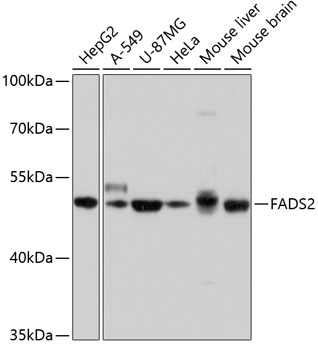-
Product Name
FADS2 Polyclonal Antibody
- Documents
-
Description
Polyclonal antibody to FADS2
-
Tested applications
WB
-
Species reactivity
Human, Mouse
-
Alternative names
FADS2 antibody; D6D antibody; DES6 antibody; FADSD6 antibody; LLCDL2 antibody; SLL0262 antibody; TU13 antibody; fatty acid desaturase 2 antibody
-
Isotype
Rabbit IgG
-
Preparation
Antigen: Recombinant fusion protein containing a sequence corresponding to amino acids 1-131 of human FADS2 (NP_004256.1).
-
Clonality
Polyclonal
-
Formulation
PBS with 0.02% sodium azide, 50% glycerol, pH7.3.
-
Storage instructions
Store at -20℃. Avoid freeze / thaw cycles.
-
Applications
WB 1:1000 - 1:2000
-
Validations

Western blot - FADS2 Polyclonal Antibody
Western blot analysis of extracts of various cell lines, using FADS2 antibody at 1:1000 dilution.Secondary antibody: HRP Goat Anti-Rabbit IgG (H+L) at 1:10000 dilution.Lysates/proteins: 25ug per lane.Blocking buffer: 3% nonfat dry milk in TBST.Detection: ECL Basic Kit .Exposure time: 3s.
-
Background
Acts as a fatty acyl-coenzyme A (CoA) desaturase that introduces a cis double bond at carbon 6 of the fatty acyl chain. Involved in biosynthesis of highly unsaturated fatty acids (HUFA) from the essential polyunsaturated fatty acids (PUFA) linoleic acid (LA) (18:2n-6) and alpha-linolenic acid (ALA) (18:3n-3) precursors. Catalyzes the first and rate limiting step in this pathway which is the desaturation of LA (18:2n-6) and ALA (18:3n-3) into gamma-linoleate (GLA) (18:3n-6) and stearidonate (18:4n-3), respectively. Subsequently, in the biosynthetic pathway of HUFA n-3 series, desaturates tetracosapentaenoate (24:5n-3) to tetracosahexaenoate (24:6n-3), which is then converted to docosahexaenoate (DHA)(22:6n-3), an important lipid for nervous system function (By similarity). Desaturates palmitate to produce the mono-unsaturated fatty acid sapienate, the most abundant fatty acid in sebum. Also desaturates (11E)-octadecenoate (trans-vaccenoate)(18:1n-9), a metabolite in the biohydrogenation pathway of LA (18:2n-6) (By similarity).
Related Products / Services
Please note: All products are "FOR RESEARCH USE ONLY AND ARE NOT INTENDED FOR DIAGNOSTIC OR THERAPEUTIC USE"
